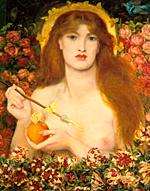Rossetti in the 1860s
The Blue Bower
February 11–May 6, 2001

Dante Gabriel Rossetti
Venus Verticordia
1864-8
Oil
38 5/8 x 27 1/2 in.
©Russell-Cotes Art Gallery and Museum/Bournemouth, UK/"Supported by the National Art Collections Fund"/Bridgeman Art Library
Dante Gabriel Rossetti (1828-1882) painted many of his most famous works–half-length allegorical representations of beautiful women–between 1859 and the end of the 1870s. These paintings, of which The Blue Bower (1865) is a defining masterpiece, were not conventional portraits but celebrations of female beauty, deriving much of their emotional impact from the symbolism of color, flowers, and music. The paintings depict women–models and mistresses whom the artist admired and loved–in lyrical and luxurious poses, often as characters from literature or mythology, sometimes alluring seductresses, sometimes dangerous sirens. Rossetti called them his "stunners."
Rossetti in the 1860s: "The Blue Bower" traces the evolution and impact of these works, examining the forces that influenced them–Asian art, Venetian Renaissance painting, music, and poetry–and relating Rossetti's paintings and drawings to those of his contemporaries. The 1860s saw the beginning of the Aesthetic Movement in Britain, which preached the doctrine of "art for art's sake" in reaction to Victorian narrative painting. While Rossetti's paintings could be viewed as contemporary expressions of women's sexual power, they were also admired purely for their aesthetic qualities. For artists like Rossetti, making a beautiful painting was more important than delivering a moral message. These fascinating and sumptuous works reveal some of the innovation, complexity, and contradictions of British art of the late nineteenth century.
This exhibition is organized by the Barber Institute of Fine Arts, the University of Birmingham, England. The Clark Art Institute is the only North American venue for this exhibition.